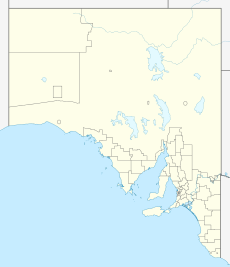Isles of St Francis Conservation Park facts for kids
.
Quick facts for kids Isles of St Francis Conservation ParkSouth Australia |
|
|---|---|
|
IUCN Category Ia (Strict Nature Reserve)
|
|
| Nearest town or city | Ceduna |
| Established | 16 March 1967 |
| Abolished | 25 August 2011 |
| Area | 12.36 km2 (4.8 sq mi) |
| Managing authorities | Department of Environment and Natural Resources (2011) |
| See also | Protected areas of South Australia |
| Isles of St Francis Conservation Park | |
|---|---|
| Official name: Register of the National Estate | |
| Designated | 21 October 1980 |
| Reference no. | 6741 |
The Isles of St Francis Conservation Park was a special place in South Australia. It was a 'protected area', which means its natural environment was kept safe. This park was located on islands in the Nuyts Archipelago, off the west coast of the Eyre Peninsula.
It was about 562 kilometers (350 miles) north-west of Adelaide, the state capital. It was also about 50 kilometers (31 miles) south-west of the town of Ceduna.
What Was the Park?
The conservation park included land on several islands within the Isles of St Francis. These islands are part of the larger Nuyts Archipelago group. The main goal was to protect the unique plants and animals living there.
How the Park Started
The protection of these islands began in 1967. First, two islands, Freeling Island and Smooth Island, were made into 'fauna conservation reserves'. This meant they were set aside to protect animals.
Later that year, more islands were added. These included Dog Island, Egg Island, Fenelon Island, Hart Island, Masillon Island, West Island, and most of St Francis Island.
In 1972, all these reserves were combined. They officially became the Isles of St Francis Conservation Park. This happened under a new law called the National Parks and Wildlife Act 1972. In 1991, even more land was added. This extended protection to areas between high and low tide marks. By 2010, the park covered about 12.36 square kilometers (4.77 square miles).
Why the Park Changed
The Isles of St Francis Conservation Park no longer exists as a separate park. On August 25, 2011, all its land became part of a larger protected area. This new area is called the Nuyts Archipelago Wilderness Protection Area. This change helped to give the islands even stronger protection.
Amazing Wildlife and Nature
The Isles of St Francis were very important for many rare and special animals. In 1980, experts described the park as a vital home for wildlife.
Mammals of the Islands
- Woylie (Brush-tailed Bettong): St Francis Island was part of a program to bring back the endangered woylie. These small marsupials had disappeared from the island in the early 1900s.
- Southern Brown Bandicoot: St Francis Island is one of only two islands in South Australia where you can find the southern brown bandicoot. This animal is considered vulnerable.
- Australian Sea Lion: Australian sea lions are one of the rarest marine mammals in the world. Important breeding groups lived on Fenelon and West Islands.
- New Zealand Fur Seal: New Zealand fur seals also used Fenelon Island as a breeding ground.
- Bush Rat: Populations of bush rats lived on Dog and Masillon Islands.
Birds of the Islands
Many rare and uncommon birds used the islands for breeding:
- Cape Barren Goose: The Cape Barren goose is the second rarest goose species globally. It bred on the Isles.
- Banded Rail: The banded rail was another important bird species found here.
- Short-tailed Shearwater: The islands supported a large breeding population of short-tailed shearwaters.
- Rock Parrot: The rock parrot also bred on the Isles.
- Little Penguin: Little penguins were another breeding bird found there.
Reptiles of the Islands
- Carpet Snake: St Francis Island was home to the carpet snake (Morelia spilota). This snake is vulnerable in South Australia and its numbers are decreasing on the mainland.
Island Environment and Plants
The islands are made of limestone and sand, sitting on granite rock. The larger islands mostly have 'coast saltbush' shrubland in lower areas. Other parts are covered in grassland and scattered low shrubs.
Some parts of St Francis Island were used for grazing sheep in the past. This caused some changes to the plants. However, the vegetation is now recovering. Other islands in the group remained in their natural state.
Protection Status
In 2010, the conservation park was classified as an IUCN Category Ia protected area. This is the highest level of protection, meaning it was a 'Strict Nature Reserve'. This classification shows how important it was to keep the area wild and untouched.
In 1980, the park was also listed on the Register of the National Estate. This was a list of places important to Australia's natural and cultural heritage.


